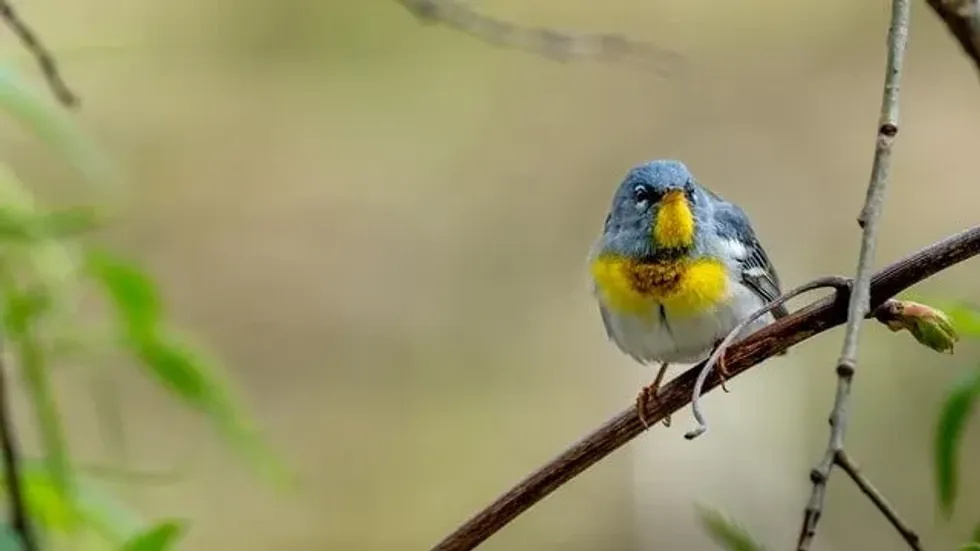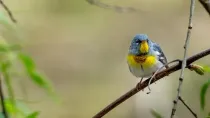Northern parulas (Setophaga Americana) belong to the family of new world warblers. They are migratory birds and are mostly found in wooded regions like evergreen or deciduous forests.
Their plumage is bluish-gray, and they have a yellow throat and breast. Their bills are pointed, and they are similar to the size of a kinglet. These North American birds are wood-warblers which are associated with Spanish moss and lichens.
Their preferred breeding grounds are along open streams, swamps, and bottomlands. The nests of Setophaga americana can be found on the upper canopy of trees located in evergreen or coniferous forests, much like other similar species.
After reading about these birds of North America, if you are interested in some more similar species, you may also look at cardinal bird facts and gouldian finch facts.
Northern Parula Interesting Facts
What type of animal is a northern parula?
The northern parula is a bird, scientifically known as the Setophaga americana. As per the Sibley Guide to Birds, they breed in North and South America and are one of the smallest bird species belonging to the family of warblers. Their diet is omnivorous in nature. They are primarily insectivores that feed on nectar and seeds as well.
What class of animal does a northern parula belong to?
Northern parula birds belong to the class of aves. During the winter period, these birds forage in open fields, pastures, scrubs, plantations, and forests. These North American birds are closely associated with moss and lichen.
How many northern parulas are there in the world?
Northern parulas are a common bird species found in America. Their population is growing steadily and the estimated global breeding population of northern parulas is 17 million.
The conservation status of parula is of the Least Concern. Northern parula distribution is unfirmly spread across Wisconsin, Michigan, New Jersey, Rhode Island and New York. For more information on the bird id of this species and where to spot them during spring migration, get hold of a field guide.
Where does a northern parula live?
Northern parulas prefer living in the woods. Evergreen and deciduous forests and thickets are where these tiny birds are found. Their nest can usually be found in a hanging clump of epiphytes like Spanish moss and beard moss. During migration and winter, they can be found in a range of habitats.
What is a northern parula's habitat?
Northern parulas cannot survive in extreme climates. Their population can be washed out due to heavy rainfall and spring heatwaves. They are migratory birds and can be found in wooded regions, Spanish moss and lichen trees. Their nests are prepared from pine needles, animal hair, and grass.
Who do northern parulas live with?
Northern parulas are migratory birds that tend to migrate alone or in pairs. They form flocks with other warblers during migration on the wintering grounds during the fall and winter seasons.
How long does a northern parula live?
The average lifespan of a northern parula is four years. They can survive in multiple habitats during summer and winter. They molt twice in a span of 12 months. They are commonly found in northern and Central America on treetops and dense forests.
How do they reproduce?
The breeding season of northern parula warblers occurs from March to August when the climate is humid. These birds breed in mature Spanish moss trees and lichens.
Females breed and lay eggs only once or twice in a whole year. An odd break in their breeding range can be observed.
This tree species breeds from North Florida to the boreal forest of Canada, and they skip breeding in Iowa, Southern Minnesota, Massachusetts, and New Jersey. The incubation period lasts for 12 to 14 days and the clutch size of these birds is two to seven eggs.
The juvenile northern parula stays in the nest for ten to 12 days before flying. During this time, the females and males both take care of these birds.
What is their conservation status?
The conservation status of northern parula is of the Least Concern. Their populations have been recorded to rise since the 1970s. They are most commonly found in central and northern America. An estimated population of 17 million northern parulas exist in the entire world.
Northern Parula Fun Facts
What do northern parulas look like?
Northern parulas are also commonly known as yellow throat parulas or yellow-breasted parulas as they display a bright yellow spot on their breast or throat region. They have two large white wing bars, a short tail, and have an overall blue-gray plumage with a short, pointed gill. They also have a distinct white ring around their eyes.
How cute are they?
They are cute, little wood warblers. They are forest dwellers and are known for their bright yellow spot. They are similar in size to a kinglet and are migratory in nature. They can live in multiple habitats depending upon the season.
How do they communicate?
Northern parulas communicate through calls and display different physical postures. They mainly have two types of songs or calls.
The first song or call is a rising buzzy trill that ends suddenly on a short note which is lower in tone. This song is described as the 'trills up, falls over' call. The second call is buzzy, which includes strings of short phrases.
How big is a northern parula?
Northern parula is a little bird belonging to the family of new world warblers found in America. They are migratory and dwell in forests and thickets. Northern parula range of size is 4.3-4.7 in (10-11 cm) on an average, and their wingspan is 6.3-7.1 in (16-18 cm).
How fast can a northern parula fly?
They fly in a quick and erratic motion with rapid wing beats and are seen to be hopping on tree branches and fluttering around them. These nesting birds also tend to attack insects in a quick manner and will make short flights from the perch by flying mid-air to catch a prey.
How much does a northern parula weigh?
The average weight of a northern parula is 0.01-0.02 lb (0.2-0.4 oz). They are similar in weight to a kinglet.
What are the male and female names of the species?
There are no different male and female names for the northern parula species.
What would you call a baby northern parula?
An immature northern parula is called a nestling.
What do they eat?
Northern parulas eat spiders, bees, caterpillars, flies, locusts, beetles, moths, ants, and wasps. During the breeding season, these nesting birds sometimes prey on bud scales and eat berries, seeds, fruits, and nectar on breeding grounds.
Are they friendly?
Even if you feed a northern parula, they will not visit you again. Northern parulas are friendly with other species of warblers and form mixed-species flocks during migration.
Would they make a good pet?
Northern parulas, if caged as a pet, will not live for a long time. These nesting birds love migrating and flying to great heights in a dense canopy. If they are locked in a cage and fed insects, they will die sooner as they are not in their natural habitat.
Did you know...
The female northern parula has a dull broad and white wing band which isn't present in males. Only the females build the nest with the help of moss and lichen, while the males only assist them while flying to the nest. The original name of the northern parula is blue yellow-backed warbler.
What does a northern parula sound like?
Northern parula song is a high-pitched trill that is buzzy. They have two distinct songs and use different vocalizations for communication and socialization. They have a rising buzzy call which ends abruptly in a lower pitch.
How to spot northern parulas?
Northern parulas can be spotted in thickets and wooded regions like dense forests on treetops and upper canopies during the migratory period. During the breeding season, the females usually build their nest on Spanish moss and old man’s beard lichen trees. They use strands of fungi to make their nests.
How rare are northern parula?
Northern parulas are an extremely common bird species in central and northern America. Their population is abundant and their behavior can be observed in thick forests which is their preferred living habitat.
Here at Kidadl, we have carefully created lots of interesting family-friendly animal facts for everyone to discover! Learn more about some other birds including palm warbler, or oven bird.
You can even occupy yourself at home by drawing one of our northern parula coloring pages.










